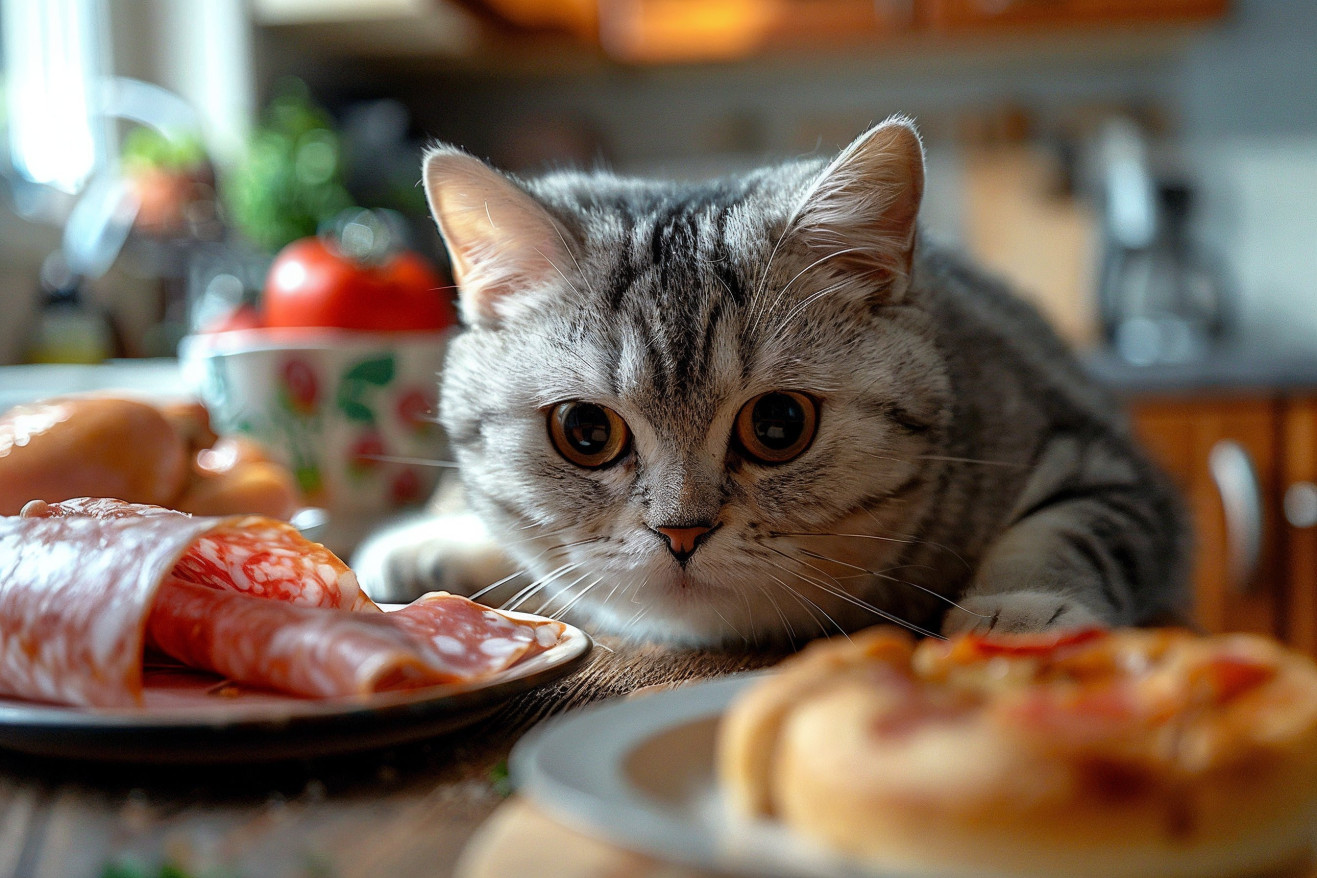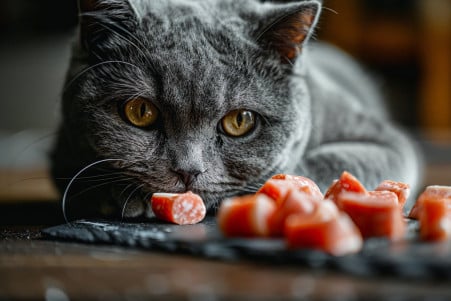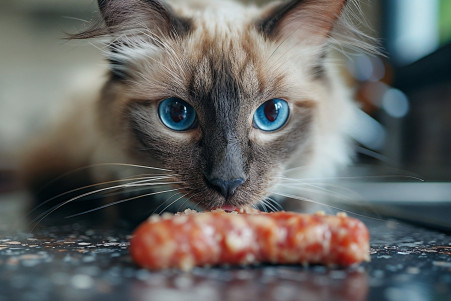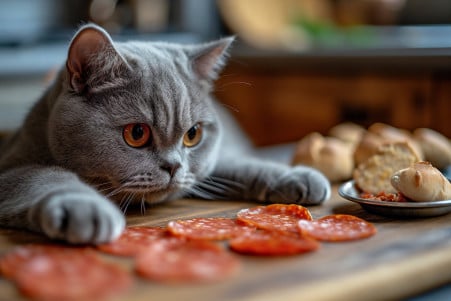Can Cats Eat Salami? Unpacking the Facts for Feline Health
6 March 2024 • Updated 4 March 2024

While salami is a popular choice for people, especially in sandwiches, you may be wondering if your cat can enjoy this cured meat as well. While cats can technically eat salami in small amounts as an occasional treat, its high fat and salt content and potential inclusion of toxic ingredients like garlic make it an unhealthy choice for cats that can lead to health problems.
To find out more about whether or not salami is safe for cats and what the potential risks and benefits are, we’ll take a look at a range of research in the fields of veterinary nutrition and toxicology. We’ll also reference animal nutritionists to know their take and look at nutritional information to find out more about how salami can impact a cat’s diet.
This will help you learn more about what to think about before giving your pet this popular deli meat so that you can make sure you’re keeping them safe and healthy.
Can cats eat salami?
Risks of Feeding Salami to Your Cat
If you’re thinking about treating your cat to a piece of salami, it’s important to think about the nutritional risks. For example, if your cat eats the high levels of sodium in salami, it will need to drink more water, and it could be at risk of salt poisoning, which can lead to symptoms like vomiting and diarrhea in severe cases, according to Cooper Pet Care.
This is especially problematic because cats have a low thirst drive, which can make it harder for them to regulate their sodium levels.
In addition, The Spruce Pets explains that cats are sensitive to preservatives like garlic, which is often found in salami, and that it can cause damage to their red blood cells. Spices, which are often used to flavor salami, can cause stomach upset in cats. The high fat content in salami can also lead to obesity and the health problems that come with it, including pancreatitis.
In light of these nutritional risks, salami is not a good choice for your cat. While an occasional bite may not be harmful, feeding your cat salami on a regular basis will expose it to unnecessary health risks. It’s better to look for healthier, cat-safe options that will meet your pet’s nutritional needs without putting it in harm’s way.
Signs of Salt Toxicity in Cats
Salt toxicity, or salt toxicosis, in cats occurs when they consume too much sodium chloride, especially if they don’t drink enough water. According to the Merck Veterinary Manual, clinical signs of salt toxicity in cats can range from depression, weakness, ataxia, and muscle fasciculations to seizures. Long-term consumption of high-sodium foods such as salami can lead to hypernatremia and the development of cerebral edema.
An article in PubMed notes that it’s important to be able to identify the clinical signs of sodium toxicosis because it can be fatal in cats. Treatment involves immediate fluid therapy and continuous monitoring of the patient’s neurological status. In addition, the Merck Veterinary Manual explains that treatment should focus on slowly normalizing the cat’s water and electrolyte levels to avoid making the condition worse.
Because salami is high in sodium, it can be dangerous for cats to eat, especially if it leads to salt toxicity. Therefore, pet owners should be sure to choose treats that provide the right nutritional value for their cats and avoid those that are high in salt to make sure their pets stay healthy.
Meeting the Nutritional Needs of Cats: Why Salami Is Not a Good Choice
Cats are obligate carnivores, which means that their nutritional requirements are different from those of other animals. In addition to needing high levels of protein, cats need certain amino acids, including taurine and arginine, essential fatty acids, and specific vitamins that are only found in animal tissue. The Clinical Nutrition Service at Cummings School notes that cats can’t make enough of these nutrients on their own, so they need to get them from their diet.
Salami, on the other hand, is high in salt and fat and low in the nutrients that cats need.
The nutritional composition of salami is not only the opposite of what cats need, but it can also be harmful to them. The high levels of sodium and fat in salami can be harmful to cats, while the lack of the essential nutrients that cats need can also be detrimental.
A healthy diet for a cat, as described by the Cornell University College of Veterinary Medicine, should meet the standards set by the Association of American Feed Control Officials and be high in animal-based protein. Salami doesn’t meet these criteria.
Feeding cats treats like salami that don’t meet their nutritional needs can lead to nutritional imbalances and health problems. For this reason, pet owners should look for treats that are formulated to meet the nutritional needs of cats. Safer options include small amounts of cooked chicken and cat treats that meet the AAFCO standards. These treats will help ensure that your cat gets the nutrition they need from their treats.
Navigating the Hidden Hazards: Preservatives in Cat Treats
The search for a healthy cat treat also brings up concerns about the preservatives used in processed meats, like salami. For example, preservatives like sodium nitrite, which is commonly used in salami, can be toxic to animals.
According to a study in PubMed, toxic levels of sodium nitrite in commercial pet food were responsible for the deaths of three cats, with the cats showing signs of methemoglobinemia, a condition that reduces the amount of oxygen that is delivered to the body’s tissues.
Vetwest Veterinary Clinics also warns pet owners about the dangers of sulphur dioxide and other sulphite preservatives in pet food, which can cause a thiamine (vitamin B1) deficiency. Thiamine is important for maintaining a cat’s brain health, and a deficiency can lead to severe neurological problems, including head tilt and paralysis, that can be life-threatening.
In addition, the RSPCA Knowledgebase reports that cats have a lower tolerance for sodium benzoate, which is another common preservative, and that it can be toxic at certain levels.
Because of these dangers, it’s important for cat owners to be discerning when choosing treats and to make sure that they don’t contain any preservatives that could be harmful to their pets. This will help ensure that the treats are not only something that your cat will enjoy but also that they will be safe and contribute to their health and well-being.
Healthy Snacking: Adding Safe Treats to Your Cat’s Diet
If you are considering giving your cat salami or any other new treat, it is important to do so in moderation and with care. Make sure to introduce new treats to your cat gradually and in small amounts so that you can monitor their reaction.
Look for signs of gastrointestinal upset, including changes in appetite, vomiting, diarrhea, or changes in behavior, as these may be signs of intolerance or toxicity. If you notice any of these symptoms, stop giving your cat the treat and contact your vet immediately.
Catster suggests healthier, nutritionally appropriate treats for cats like boiled chicken, lean turkey, or cooked salmon that are more in line with their natural diet.
WebMD also offers a list of human foods that are safe for cats that you can use to make sure your cat has a variety of treats that are also good for them. Just make sure to keep treats to a minimum and prioritize a balanced, species-appropriate diet, as CatInfo stresses.
To be safe, always check with your vet before adding any new food items to your cat’s diet on a regular basis. By prioritizing your cat’s dietary needs and seeking out professional advice, you can make sure that your cat stays healthy and happy.
Final Thoughts: Cat Treats and Salami
As we’ve asked the question, “Can cats eat salami?” we’ve made a few things clear. The high levels of salt and fat in salami, as well as the presence of garlic and other spices, make it a risky snack for cats. We’ve also looked at the dangers of salt poisoning, which emphasizes the need for moderation and an understanding of your cat’s dietary needs.
Veterinarians don’t recommend feeding salami to cats because it doesn’t meet their nutritional needs and it contains preservatives that could be toxic. It’s up to us as cat owners to make sure that the treats we give our cats are in line with their needs as obligate carnivores and not our own tastes as humans.
We hope that cat owners will make informed decisions about the treats they give their pets, and that those decisions will be based on research and the advice of veterinarians. We also hope that cat parents will spoil their pets with treats while also making sure that the treats they give them are healthy.
After all, a cat’s diet is a key component of their well-being, and it’s important to make sure that every treat you give them has a positive impact on their life.


